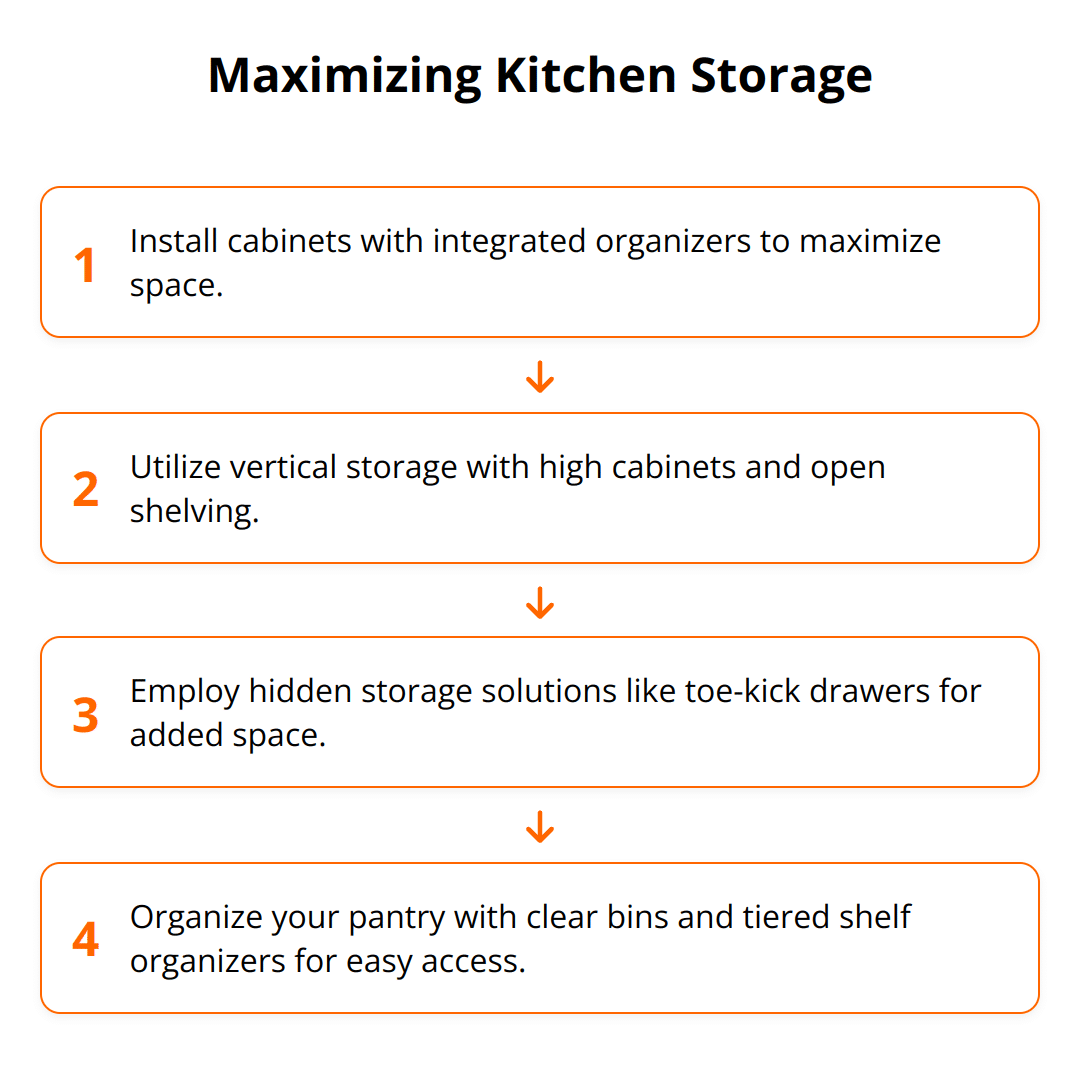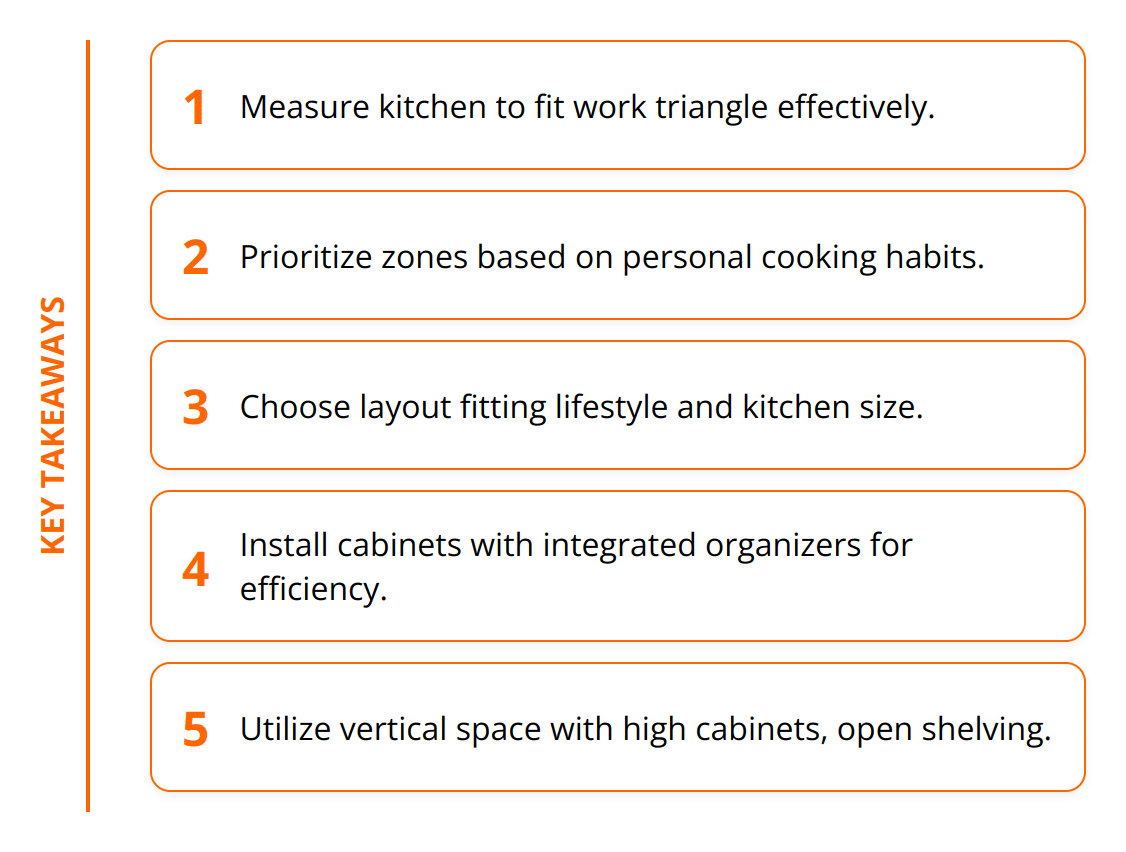
A well-planned kitchen is not just about aesthetics; it’s about creating a space that enhances your daily routine and makes cooking a pleasure. We at JBS Remodeling understand that every homeowner has unique needs and that’s why we’re here to help optimize your kitchen’s layout for maximum efficiency. This guide will walk you through the critical aspects of kitchen planning, from effective work zones to smart storage solutions. Transform your kitchen into a functional, welcoming space tailored to your lifestyle.
Optimizing Kitchen Workflow
A kitchen’s efficiency hinges on its layout, specifically designed around the concept of work zones. The idea is to minimize wasted steps and create a smooth flow of activities. The efficiency of a kitchen layout is dramatically determined by how well it adheres to the kitchen work triangle principle, which emphasizes the placement of the three most critical areas: cooking, cleaning, and storage.
The Kitchen Work Triangle Simplified
The work triangle connects the refrigerator (storage), sink (cleaning), and stove (cooking). Keeping these elements within an efficient distance of each other ensures that meal preparation is streamlined. Ideally, each leg of the triangle should be between 4 and 9 feet, and the total sum of the triangle’s three sides should not exceed 26 feet. This setup avoids unnecessary steps but also keeps them adequately spaced to prevent crowding in one zone.
Creating Effective Work Zones
Beyond the triangle, dividing the kitchen into distinct zones for each task can vastly improve functionality. Each zone should be equipped with the tools and space needed for its specific task. Here are the primary zones to consider:
-
Preparation Zone: This area should have ample counter space for chopping, mixing, and assembling dishes. It’s best located between the fridge and the sink or the sink and the cooktop, where ingredients can be washed, prepared, and then cooked in a seamless flow.
-
Cooking Zone: Home to the stove and oven, this zone should also include easy access to pots, pans, and cooking utensils. Placing the cooking zone near natural ventilation or fitting an efficient range hood can mitigate smoke and odors.
-
Cleaning Zone: Centered around the sink, the cleaning zone should have easy access to the dishwasher, waste disposal, and cleaning supplies. Efficient designs place the dishwasher close to the sink but ensure it doesn’t interfere with the area’s workflow in open or closed positions.
-
Storage Zone: Involves both the refrigerator and storage for food, cookware, utensils, and small appliances. Splitting storage into “cold” (fridge and freezer) and “dry” (pantry and cabinets) ensures items are conveniently at hand where they are most needed.
Merging Zones for Efficiency
While segregating the kitchen into zones, it’s vital to ensure they complement each other rather than creating isolated islands of activity. For instance, preparation and cooking zones should seamlessly connect, allowing for easy transition from chopping to frying.
Incorporating these zones into your kitchen layout encourages a natural workflow that can transform meal preparation from a chore to a delight. For more tailored advice on creating the perfect kitchen layout, our guide on kitchen renovation planning provides actionable steps.

Actionable Tips:
-
Measure your kitchen’s dimensions to understand how much space you have to implement the work triangle.
-
Observe your cooking habits to identify which zones you use most frequently and prioritize their accessibility.
-
Utilize kitchen layout tools online for a 3D visualization of your potential layout changes.

Implementing these strategies ensures your kitchen is not only a place of culinary creation but a model of efficiency where every task, from preparation to cleanup, is optimized for speed and ease.
Choosing Your Kitchen Layout
Selecting the right kitchen layout is essential for achieving maximum efficiency. The layout impacts everything from meal prep to your ability to entertain guests comfortably. While there are several popular layouts, including L-Shape, U-Shape, Galley, and Island, picking the one that best suits your space and lifestyle requires careful consideration.
L-Shape, U-Shape, Galley, or Island?
L-Shape: Ideal for small to medium kitchens, this layout maximizes corner space, providing an open area to move around. It supports the kitchen triangle effectively but may limit the number of cooks.
U-Shape: Perfect for homes with ample kitchen space. It offers extensive counter and storage space but requires careful placement of zones to avoid a cramped feeling.
Galley: Efficient for tight spaces, the galley layout includes two parallel countertops, creating an efficient cooking zone. However, it might not suit those who prefer open spaces or entertain frequently.
Island: Combining aesthetics with functionality, an island can be a focal point for socializing while providing extra counter space and storage. It works best in larger kitchens and when well-planned, enhances the workflow significantly.

Evaluating Space and Needs
Understanding the limitations and possibilities of your kitchen space is crucial. Measure your kitchen accurately and consider the existing windows, doors, and fixed appliances as these will influence your layout choice. Reflect on your lifestyle; if you love entertaining, an open-plan kitchen with an island might suit you better than a galley layout. On the other hand, if space is at a premium, an efficient L-shape or galley could be the way to go.
Open-Concept Kitchens and Entertaining
Open-plan kitchens have become increasingly popular, encouraging interaction between the kitchen and living areas. If you’re leaning towards this style, consider how the kitchen blends with adjacent spaces. An island layout often serves as a great transition, providing a communal area for guests to gather while you cook.
Remember, the key to a functional kitchen is not just in choosing the right layout but in tailoring it to accommodate your habits and lifestyle. For further insights, explore our guide on creating efficient kitchens.
Practical Tips:
-
Measure your kitchen space before settling on a layout.
-
Think about your lifestyle and how you use your kitchen.
-
Use online tools to visualize layout options.
-
Consider professional advice for optimizing an open-plan kitchen.
Choosing the right kitchen layout is a balance between functional design and personal taste. By carefully evaluating your space, needs, and the unique characteristics of each layout, you can create a kitchen that not only looks great but enhances your home life.
Smart Storage Solutions
Maximizing kitchen storage involves innovative approaches to design, layout, and organization. Efficient storage not only clears clutter but also enhances the functionality of your kitchen, making every square inch work harder for you.
Think Beyond Traditional Cabinets
The evolution of cabinet designs has brought about features that maximize space and accessibility. Consider installing cabinets with pull-out drawers, lazy Susans, and integrated organizers. These elements allow for easier access to pots, pans, and other necessities, eliminating the need to dig through deep cabinets. For those aiming to modernize their kitchen, deep drawers are particularly effective for storing larger items such as pot and pans close to the cooking zone, streamlining the cooking process.
Vertical Space: Your Unseen Ally
Kitchens often underutilize their vertical space. High wall cabinets, hanging pot racks, and ceiling-mounted storage can make a significant difference in how much you can store. Open shelving offers another layer of storage while keeping your most frequently used items within easy reach. Additionally, consider installing custom cabinetry that extends to the ceiling to fully capitalize on available vertical space, thereby providing a home for lesser-used items that otherwise clutter counters and drawers.
Hidden Storage: The Art of Concealment
With the right design, the kitchen can offer hidden storage solutions that are both functional and aesthetically pleasing. Toe-kick drawers at the bottom of your cabinets provide a sneaky yet brilliant space for storing flat items like baking sheets and cutting boards. Similarly, integrating appliance garages for small devices such as toasters and blenders keeps them accessible but out of sight, maintaining a tidy kitchen counter.
Pantry Organization: A Structured Approach
A well-organized pantry is the backbone of a functional kitchen. Employing clear bins, baskets, and organizers allows for categorizing pantry items, making them easier to find and reducing duplication. Consider using tiered shelf organizers to maximize pantry space and make even the back of the shelf accessible. For those looking to take their pantry organization to the next level, sliding pantry shelves or drawers can significantly enhance visibility and access to stored items.

Incorporating smart storage solutions into your kitchen design not only streamlines your daily routine but also transforms your kitchen into a space of convenience and efficiency. For more inspiration on kitchen organization, explore our guide on kitchen renovation tips.
By rethinking how you use your kitchen’s square footage and implementing these strategic storage options, you’ll enjoy a kitchen that’s both beautiful and brilliantly organized, making every cooking experience a pleasure.
Final Thoughts
Planning an efficient kitchen layout goes beyond just selecting the right appliances or cabinetry; it’s about creating a space that caters to your unique lifestyle and cooking habits. Through thoughtful design and strategic organization, you have the power to transform your kitchen into a pinnacle of efficiency and joy.

Key to this transformation is understanding the work triangle principle and optimizing your kitchen’s workflow by effectively utilizing work zones. This foundation not only streamlines your meal preparation but also enhances your overall cooking experience. Moreover, embracing smart storage solutions can dramatically improve your kitchen’s functionality, making every inch count.
It’s vital to tailor the layout to your lifestyle, ensuring it supports your daily routines and culinary adventures. Whether you entertain frequently or prefer intimate family meals, your kitchen should reflect these preferences in its design and functionality. Consider factors like the layout, storage, and organization in relation to how you use your kitchen.
We encourage you to rethink and customize your kitchen layout for maximum efficiency. This might involve reevaluating your current storage systems, incorporating innovative solutions, or even a complete remodel to better suit your needs. By doing so, you’ll not only create a space that’s a joy to cook in but also increase the value of your home.
At JBS Remodeling, we specialize in bringing your dream kitchen to life. With over a decade of experience in kitchen and bath renovations, we understand the importance of a personalized approach. Our team is committed to delivering exceptional workmanship and customer service, ensuring your renovation journey is as seamless and satisfying as your new kitchen.
Transform your kitchen into a model of efficiency and style by embracing these principles and seeking professional guidance. Let us help you achieve the kitchen you’ve always wanted, where every meal preparation is a pleasure, and every gathering is memorable.
